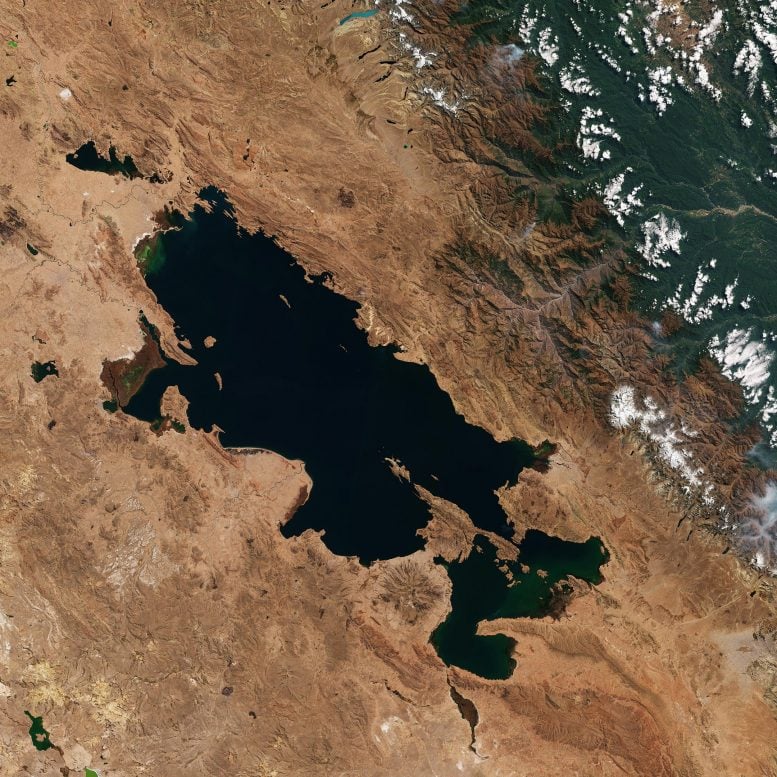
Lake Titicaca imaged by the Copernicus Sentinel-2 mission. Lake Titicaca is a designated Ramsar Site of International Importance, as the waters of Titicaca are essential to the wellbeing of millions of people who rely on the lake for agriculture, fishing and tourism, as well as water birds and animals that live along and on its shores. Credit: Contains modified Copernicus Sentinel data (2020), processed by ESA, CC BY-SA 3.0 IGO
Ahead of World Wetlands Day, the Copernicus Sentinel-2 mission takes us over Lake Titicaca – one of the largest lakes in South America.
Covering an area of around 8,300 sq km (3,200 sq mi), Lake Titicaca lies on the high Andes plateau and straddles the border between Peru (to the west) and Bolivia (to the east). It is considered the highest major body of navigable water in the world, as it sits at an elevation of 3800 m (12,500 ft) above sea level.
The lake extends approximately 190 km (120 mi) from northwest to southwest and is 80 km (50 mi) across at its widest point. Tiquina, a narrow strait, actually separates the lake into two separate bodies of water. The larger subbasin in the northwest is called Lake Chucuito in Bolivia and Lake Grande in Peru, while the smaller in the southeast is referred to as Lake Huiñaymarca in Bolivia and Lake Pequeño in Peru.
Many rivers drain into the lake, including the Ramis, one of the largest, visible in the northwest corner of the lake. The smaller Desaguadero river drains the lake at its southern end, which then flows south through Bolivia. This outlet only accounts for a small percentage of the lake’s excess water, as the rest is lost by evaporation caused by persistent winds and intense sunlight.
Forty-one islands rise from Titicaca’s waters, the largest of which, Titicaca Island, or Isla del Sol in Spanish, can be seen just off the tip of the Copacabana Peninsula in Bolivia. Several green algal blooms can be seen in the lake, including in the lake’s northwest and southeast corners. Snow in the Andes mountain range can be seen in the top-right of the image.
Lake Titicaca is a designated Ramsar Site of International Importance, as the waters of Titicaca are essential to the wellbeing of millions of people who rely on the lake for agriculture, fishing, and tourism, as well as water birds and animals that live along and on its shores.
The 2 February marks the anniversary of the signing of the Convention on Wetlands of International Importance, known as the Ramsar Convention, in Ramsar, Iran in 1971. World Wetlands Day aims to raise global awareness about the vital role of wetlands for our planet and population.
From their vantage point of 800 km high, Earth-observing satellites provide data and imagery on wetlands that can be used to monitor and manage these precious resources sustainably. For example, both the Copernicus Sentinel-2 and Sentinel-3 missions have recently been used to monitor the variation of chlorophyll concentrations in the lake and help detect trends and hotspots over time.









I read somewhere in the past, stories of the local indigenous people who lived around the lake, who reported alien visitors who would extract minerals from the lake. They said it was a very happy time when the aliens visited.